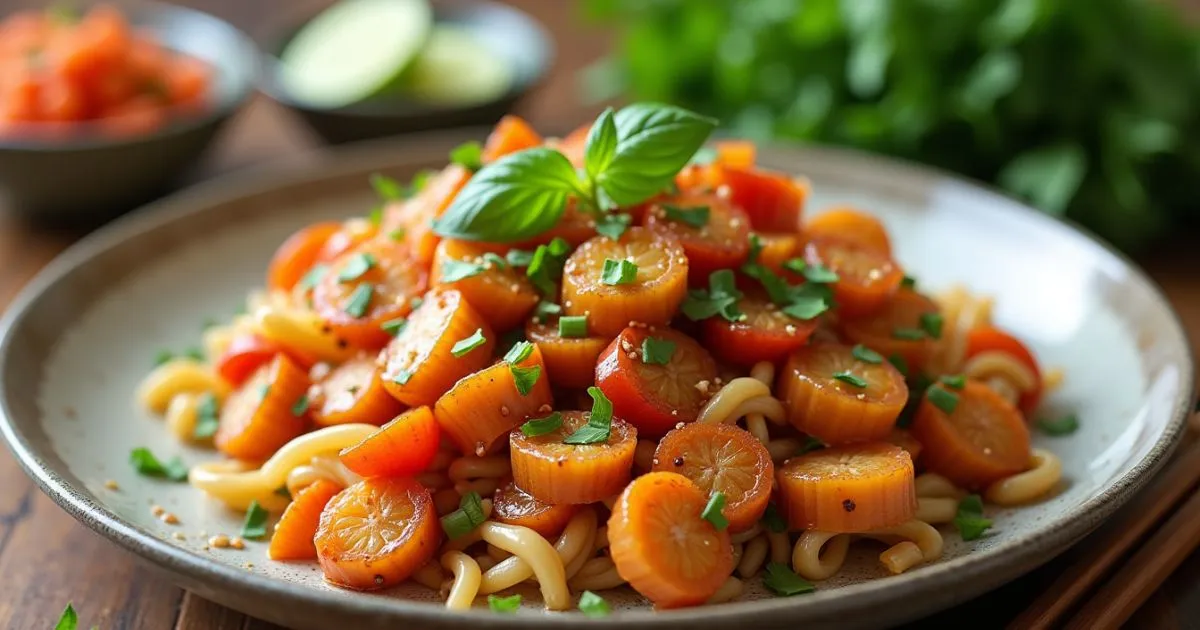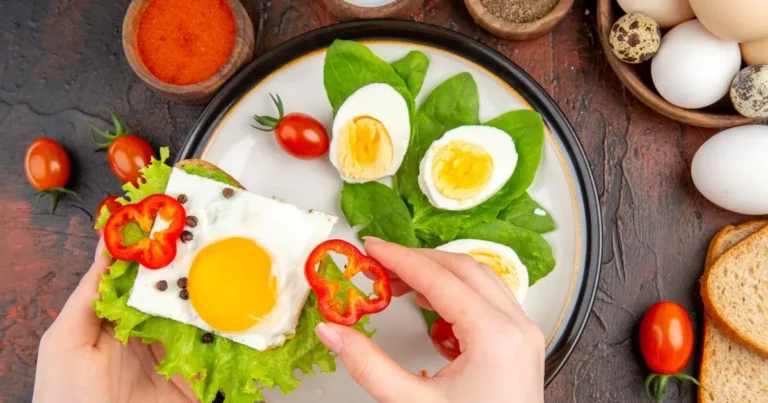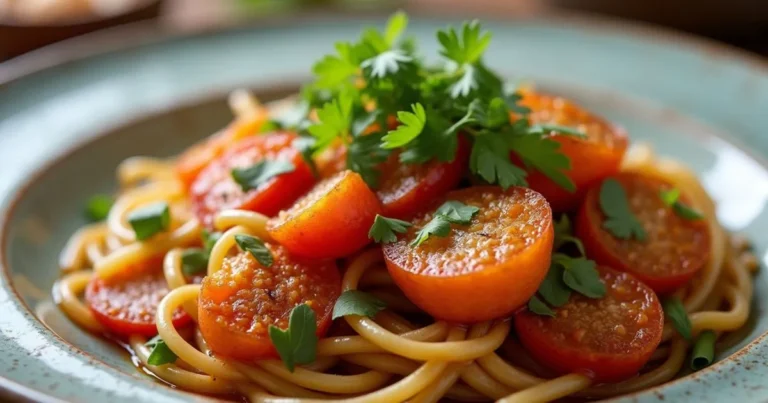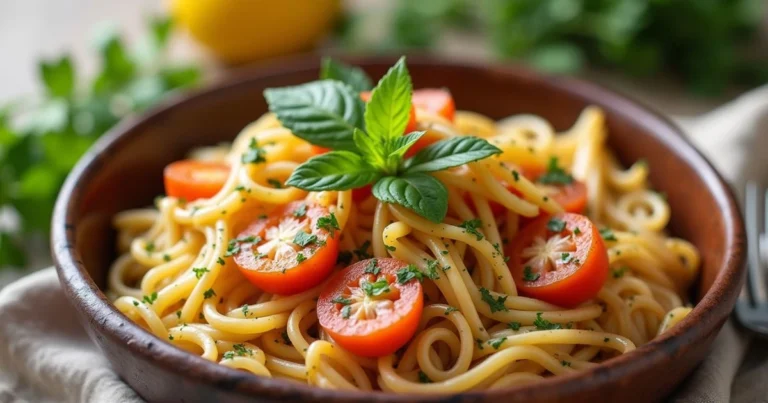Easy to Make Asian Food Recipes: 20 Simple Dishes That Bring Restaurant Flavors to Your Kitchen
The first time you experienced that perfect balance of sweet, salty, and umami in authentic Asian cuisine, something shifted in your understanding of food. Maybe it was the silky texture of ramen broth that seemed to heal your soul on a cold evening, or the satisfying crunch of fresh vegetables in a homemade stir-fry that made you realize takeout could never compare to what you could create at home.
For too many home cooks, Asian cuisine feels intimidating – shrouded in mystery with unfamiliar ingredients and seemingly complex techniques. The truth is, many beloved Asian dishes originated as humble, everyday meals designed to nourish families quickly and affordably. These recipes were born from necessity, using simple ingredients transformed through time-tested techniques into the comfort foods that have sustained entire cultures for generations.
Today, you’re about to discover that creating authentic Asian flavors in your own kitchen isn’t just possible – it’s surprisingly simple. These easy to make Asian food recipes will transform your weeknight dinners from mundane to magnificent, connecting you to culinary traditions that celebrate fresh ingredients, balanced flavors, and the joy of sharing meals with those you love.
Table of Contents
Why Master Easy Asian Cooking at Home?

Your journey into Asian home cooking offers remarkable benefits beyond just delicious meals. Studies show that traditional Asian cooking methods like steaming and stir-frying preserve more nutrients compared to typical Western cooking techniques. The emphasis on fresh vegetables, lean proteins, and minimal processing creates naturally healthier meals for your family.
From a financial perspective, preparing these dishes at home saves substantial money. The average American family spends over $3,000 annually on restaurant meals, with Asian cuisine representing a significant portion. Learning these recipes cuts your dining costs by 60-70% while giving you complete control over ingredients and portions.
Health advantages you’ll gain include:
- Reduced sodium intake compared to restaurant versions
- Higher vegetable consumption through diverse preparations
- Better portion control and ingredient quality
- Elimination of preservatives and artificial additives
- Increased fiber and antioxidant intake from Asian vegetables
The time efficiency of most Asian cooking techniques means you can create complete meals in 20-30 minutes. Unlike complex Western dishes requiring hours of preparation, stir-fries and noodle dishes come together quickly once ingredients are prepped.
Essential Pantry Staples for Easy Asian Food Recipes
Building your Asian pantry doesn’t require expensive specialty shopping trips. Most ingredients are available at regular supermarkets, and many have long shelf lives, making them excellent investments for your cooking future.
Must-Have Sauces and Condiments
Your sauce collection forms the foundation of Asian flavor profiles. Start with these versatile basics that appear in countless recipes:
Soy sauce serves as your primary umami builder. Light soy sauce works best for most dishes, while dark soy adds color and deeper flavor to braised items. Low-sodium versions help you control salt levels without sacrificing taste.
Sesame oil provides distinctive nuttiness that defines many Asian dishes. Purchase toasted sesame oil for maximum flavor impact – a little goes far, so small bottles work perfectly.
Rice vinegar and mirin bring balancing acidity and subtle sweetness to marinades and sauces. These ingredients help achieve that characteristic Asian flavor harmony.
Oyster sauce and hoisin sauce add richness and complexity to stir-fries and glazes. Both keep well refrigerated and transform simple vegetables into restaurant-quality sides.
Fundamental Dry Ingredients
Your pantry foundation includes several rice varieties and noodle types that form the base for countless meals. Jasmine rice provides fragrant, fluffy results for most dishes, while short-grain varieties work better for sushi and certain Korean preparations.
Stock various Asian noodle types including rice noodles for pad thai and pho, udon for Japanese comfort food, and soba for cold preparations. These dried noodles store indefinitely and cook quickly when needed.
Cornstarch becomes essential for velveting proteins and creating glossy sauce textures. This technique, used in professional kitchens, ensures tender meat and restaurant-quality presentations.
Fresh Aromatics That Make the Difference
The combination of ginger, garlic, and scallions appears so frequently in Asian cooking that many chefs call it the “holy trinity.” These aromatics form the flavor base for most stir-fries, soups, and marinades.
Fresh ginger keeps well in the refrigerator for weeks and freezes excellently for grating. Garlic stores at room temperature, while scallions stay fresh refrigerated for up to a week.
Consider growing fresh herbs like cilantro and Thai basil if you cook Asian food regularly. These herbs lose flavor quickly when dried but transform dishes when used fresh.
Quick and Easy Asian Stir-Fry Recipes
Stir-frying represents the quickest path to delicious Asian meals. Once you master this fundamental technique, countless recipe variations become possible using whatever ingredients you have available.
Classic Chicken Fried Rice
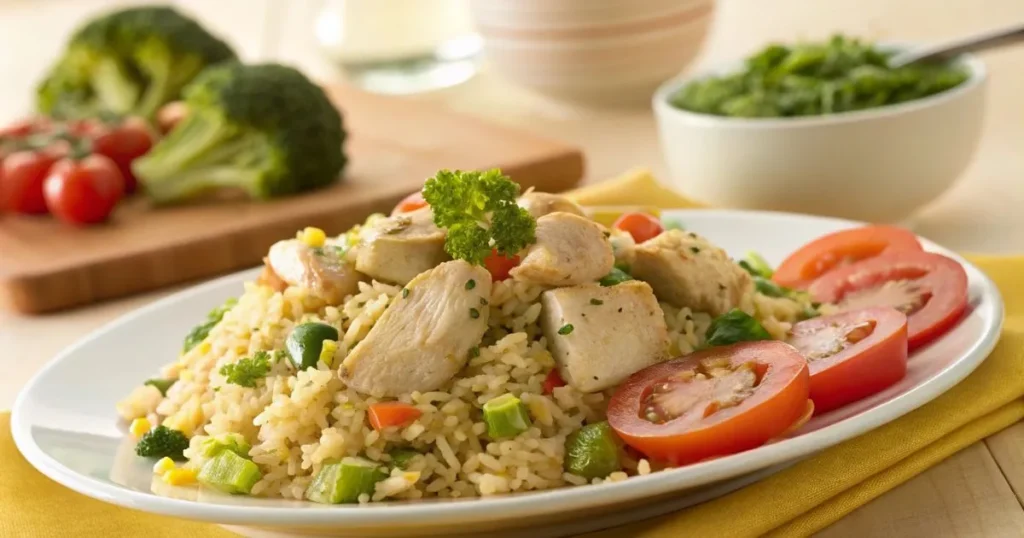
This beloved dish transforms leftover rice into a complete meal in just 15 minutes. The secret lies in using day-old rice that has dried slightly, preventing the mushy texture common in homemade versions.
| Ingredient | Quantity | Notes |
|---|---|---|
| Day-old cooked rice | 4 cups | Refrigerated overnight |
| Chicken breast | 1 lb | Cut into small cubes |
| Eggs | 3 large | Beaten with pinch of salt |
| Mixed vegetables | 2 cups | Peas, carrots, corn |
| Soy sauce | 3 tablespoons | Light variety preferred |
| Sesame oil | 1 tablespoon | For finishing |
| Vegetable oil | 2 tablespoons | For cooking |
| Garlic cloves | 3 large | Minced fine |
| Green onions | 4 stalks | Sliced thin |
Cooking Process:
Heat your wok or large skillet over high heat until smoking. Add oil and swirl to coat. Cook beaten eggs first, scrambling quickly and removing to a plate. Add more oil if needed, then stir-fry chicken until golden and cooked through.
Push chicken to one side and add garlic to the empty space. Cook for 30 seconds until fragrant, then add rice, breaking up clumps with your spatula. Stir everything together and add vegetables, cooking until heated through.
Return eggs to the pan along with soy sauce and sesame oil. Toss everything together and garnish with sliced green onions. The entire process takes under 15 minutes once ingredients are prepped.
Honey Garlic Beef Stir-Fry
This crowd-pleasing recipe demonstrates how simple ingredient combinations create complex flavors. The honey caramelizes slightly during cooking, creating a glossy coating that clings to tender beef strips.
Cut your beef against the grain into thin strips for maximum tenderness. Marinate briefly in cornstarch and soy sauce to create that signature restaurant texture through the velveting technique.
Thai Basil Chicken (Pad Kra Pao)
One of Thailand’s most popular dishes, this spicy stir-fry takes less than 20 minutes from start to finish. The key ingredient, Thai holy basil, can be substituted with regular basil if unavailable, though the flavor will differ slightly.
Ground chicken works best for authentic texture, but you can use diced chicken breast or thighs. Serve over jasmine rice with a fried egg on top for the traditional presentation.
Simple Asian Noodle Dishes for Busy Weeknights
Noodle dishes offer incredible versatility and speed for weeknight cooking. Most Asian noodle preparations follow similar patterns: cook noodles, prepare aromatics and proteins, combine with sauce, and toss everything together.
Chicken Lo Mein in 20 Minutes
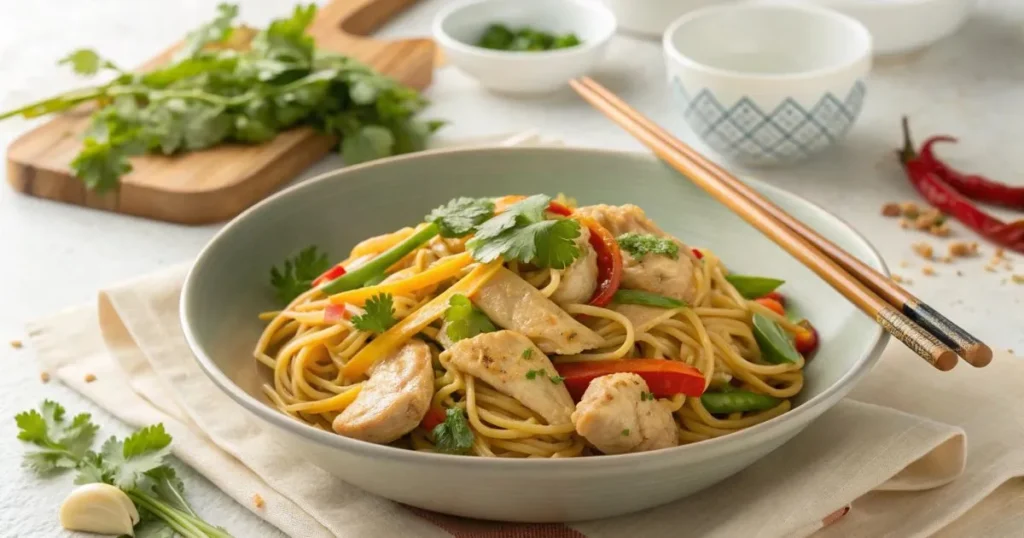
Restaurant-style lo mein relies on proper noodle cooking and sauce ratios. Fresh lo mein noodles work best, but dried spaghetti makes an acceptable substitute when cooked slightly past al dente.
The sauce combination of soy sauce, oyster sauce, and a touch of sugar creates that familiar takeout flavor. Add vegetables like bell peppers, snap peas, and carrots for color and nutrition.
Vietnamese Pho (Simplified Home Version)
Traditional pho requires hours of simmering bones for authentic broth, but your weeknight version uses quality store-bought beef or chicken broth enhanced with Asian aromatics.
Toast whole spices like star anise, cinnamon, and cloves in a dry pan before adding to simmering broth. This step intensifies flavors dramatically. Add fish sauce, rock sugar, and ginger for authentic taste profiles.
Fresh rice noodles cook quickly in hot broth, while garnishes like bean sprouts, cilantro, lime wedges, and jalapeños let each person customize their bowl.
Thai Pad See Ew
This beloved street food dish features wide rice noodles stir-fried with dark soy sauce, creating characteristic slightly charred flavors. Chinese broccoli (gai lan) is traditional, but regular broccoli works perfectly.
The key lies in achieving high enough heat to create “wok hei” – that distinctive smoky flavor from proper stir-frying. Don’t overcrowd your pan, and work in batches if necessary.
Healthy Asian Soup Recipes Ready in 30 Minutes
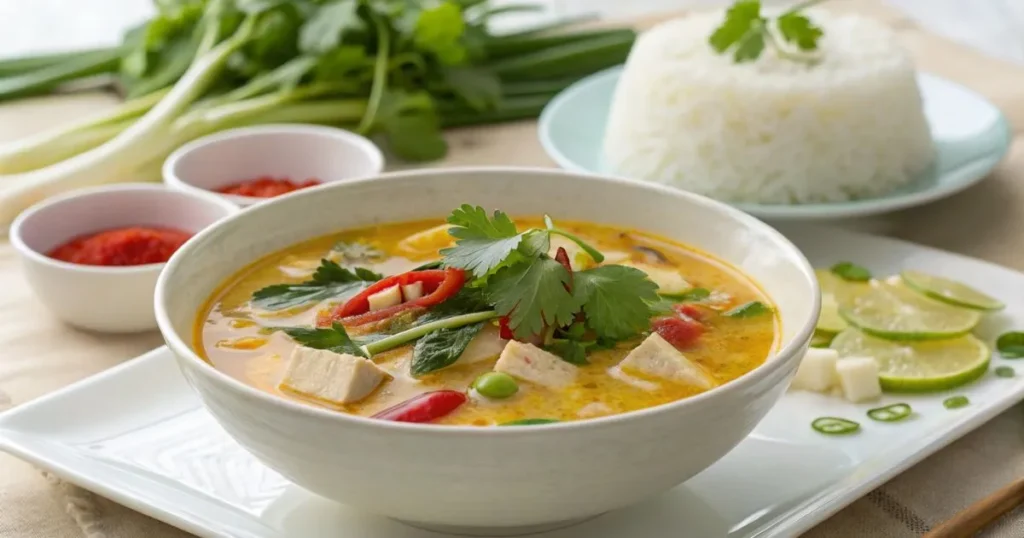
Asian soups provide comfort, nutrition, and satisfaction with minimal effort. Most follow simple formulas: build flavorful broth, add proteins and vegetables, finish with garnishes and seasonings.
Miso Soup with Tofu and Seaweed
This Japanese staple takes just 10 minutes but provides probiotics, protein, and essential minerals. Quality miso paste makes all the difference – look for naturally fermented varieties without additives.
Never boil miso directly, as high temperatures destroy beneficial bacteria. Instead, whisk miso with a small amount of warm broth before adding to the pot.
Wakame seaweed rehydrates quickly in warm liquid, while silken tofu adds protein without heaviness. Finish with sliced scallions for color and mild onion flavor.
Korean Kimchi Jjigae (Kimchi Stew)
Fermented kimchi creates incredibly flavorful broth with minimal effort. Older, more sour kimchi works better than fresh for this application. The fermentation provides natural umami depth that would otherwise require hours of cooking.
Add protein through pork shoulder, spam, or tofu depending on preferences. The dish improves with short simmering, allowing flavors to meld completely.
Thai Tom Yum Goong (Shrimp Soup)
This iconic soup balances hot, sour, sweet, and salty elements perfectly. Lemongrass, galangal, and kaffir lime leaves provide authentic aromatics, though ginger can substitute for galangal if needed.
Fish sauce and lime juice create the characteristic flavor profile, while Thai chilies provide heat. Adjust spice levels according to your tolerance.
Mastering Essential Asian Cooking Techniques
Understanding core techniques allows you to adapt any recipe and create your own variations. These methods appear across different Asian cuisines with minor variations.
Stir-Fry Success Secrets
High heat is crucial for proper stir-frying. Your pan should be hot enough that water droplets sizzle and evaporate immediately. This temperature creates the characteristic “wok hei” flavor that distinguishes restaurant cooking from home versions.
Prepare all ingredients before heating your pan. Stir-frying happens quickly, leaving no time for chopping or measuring once cooking begins. This mise en place approach ensures smooth execution and prevents burning.
Cut ingredients uniformly for even cooking. Proteins and vegetables should be similar sizes to finish cooking simultaneously. Arrange ingredients in order of cooking time, adding longest-cooking items first.
Velveting Proteins for Restaurant Texture
This professional technique involves marinating proteins in cornstarch, egg white, and seasonings before cooking. The coating creates incredibly tender textures and prevents overcooking.
Marinate sliced chicken, beef, or pork for 30 minutes minimum. The cornstarch forms a protective barrier during high-heat cooking, while egg white adds silkiness.
Perfect Rice Every Time
Proper rice cooking forms the foundation for countless Asian meals. The absorption method works reliably for most rice varieties using a 1.5:1 water-to-rice ratio for jasmine rice.
Rinse rice until water runs clear to remove excess starch. This prevents gummy textures and allows individual grains to remain separate.
Bring water and rice to a boil, then reduce heat to lowest setting and cover tightly. Cook for 18 minutes without lifting the lid, then rest off heat for 10 minutes before fluffing with a fork.
Frequently Asked Questions About Easy to Make Asian Food Recipes
What are the easiest Asian food recipes for beginners to start with?
The easiest Asian food recipes for beginners include fried rice, basic stir-fries, and miso soup. These dishes use simple techniques, common ingredients, and forgive timing mistakes. Fried rice particularly excels for beginners because it uses leftover rice and whatever vegetables you have available.
Can I make authentic Asian food recipes without specialty ingredients?
Many easy to make Asian food recipes adapt well using common grocery store ingredients. Soy sauce, garlic, ginger, and rice form the foundation for dozens of authentic dishes. While specialty ingredients enhance flavors, substitutions often work well enough to create satisfying meals.
How long do most easy Asian food recipes take to prepare?
Most easy to make Asian food recipes take 15-30 minutes total time. Stir-fries typically cook in 10-15 minutes once ingredients are prepped, while soups may need 20-25 minutes for proper flavor development. Preparation time varies based on chopping requirements and marinating needs.
What cooking equipment do I need for Asian recipes at home?
Essential equipment for easy to make Asian food recipes includes a large skillet or wok, sharp knife, cutting board, and rice cooker (optional). Most recipes adapt to standard kitchen tools, though a wok provides better heat distribution for stir-frying.
Are homemade Asian recipes healthier than restaurant versions?
Yes, homemade easy to make Asian food recipes typically contain less oil, sodium, and additives compared to restaurant versions. You control ingredient quality and quantities, often resulting in more vegetables and appropriate portions. Restaurant dishes frequently use excess oil and sodium for enhanced flavors.
How can I make Asian recipes more budget-friendly?
Make easy to make Asian food recipes budget-friendly by buying ingredients in bulk, using seasonal vegetables, choosing economical protein cuts, and preparing large batches for multiple meals. Rice, noodles, and basic sauces cost little but stretch far when combined with vegetables.
Transform Your Kitchen Into an Asian Culinary Adventure
Your exploration into easy to make Asian food recipes opens doors to incredible flavors, healthier eating habits, and significant cost savings. These time-tested techniques and ingredient combinations have nourished families for generations while adapting beautifully to modern lifestyles and ingredient availability.
The skills you’ve discovered – proper stir-frying methods, sauce building, and ingredient preparation – extend far beyond individual recipes. These fundamentals allow you to improvise confidently, adapt dishes to your family’s preferences, and create satisfying meals from whatever ingredients you have available.
Remember that mastery comes through practice and experimentation. Start with recipes that excite your palate, then gradually expand your comfort zone with new techniques and flavor profiles. Each successful dish builds confidence and develops your intuitive understanding of Asian flavor principles.
The beauty of Asian cooking lies in its flexibility and emphasis on fresh, simple ingredients transformed through proper technique. Whether you’re creating a quick weeknight stir-fry or preparing a more elaborate weekend feast, these recipes connect you to rich culinary traditions while fitting perfectly into your modern life.
Ready to revolutionize your weeknight dinners? Choose one recipe from this collection that appeals to your taste preferences and gather your ingredients today. Your family will be amazed at the restaurant-quality flavors emerging from your own kitchen, and you’ll discover the immense satisfaction that comes from mastering these beloved culinary traditions.
Start cooking today – your delicious Asian food adventure awaits!
Did You Try Our Recipe ?
There are no reviews yet. Be the first one to write one.

